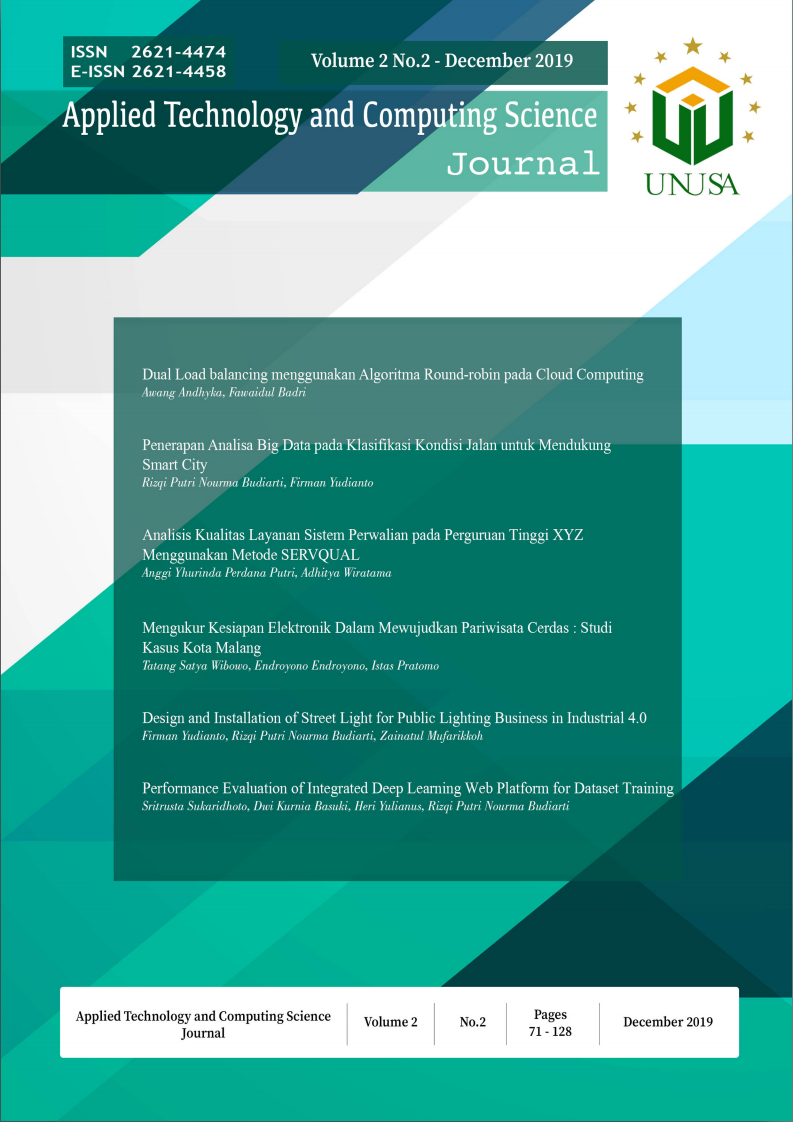Performance Evaluation of Integrated Deep Learning Web Platform for Dataset Training
Main Article Content
Abstract
Along with the complexity of recent web site, many users cannot get the benefits. We developed Integrated Deep Learning Web Platform to help researcher to prepare dataset trainig for Tensorflow. However, the quality of a web site needs to be assessed. This paper proposes an implementation of WebQual 4.0 for evaluating Integrated Deep Learning Platform for Training Dataset (INDEF) quality. This method used the WebQual model that has some instruments. The instruments grouped the WebQual questions to be three main categories; usability, information and service interaction. From the research conducted can be evaluated that all respondents agreed Integrated Deep Learning Platform for Training Dataset web site met all the WebQual characteristics.
Downloads
Article Details
References
[2] S. Barnes and R. Vidgen, “Association for Information Systems AIS Electronic Library (AISeL) WebQual: An Exploration of Website Quality Recommended Citation WebQual: An Exploration of Web-site Quality,” 2000.
[3] Y. Yohanie et al., “Implementation of Integration VaaMSN and SEMAR for Wide Coverage Air Quality Monitoring,” TELKOMNIKA, vol. 16, no. 6, pp. 2630–2642, 2018.
[4] A. M. R. Ulil, S. Sukaridhoto, A. Tjahjono, D. K. Basuki, and others, “The Vehicle as a Mobile Sensor Network base IoT and Big Data for Pothole Detection Caused by Flood Disaster,” in IOP Conference Series: Earth and Environmental Science, 2019, vol. 239, no. 1, p. 12034.
[5] A. Rasyid et al., “Pothole Visual Detection using Machine Learning Method integrated with Internet of Thing Video Streaming Platform,” in 2019 International Electronics Symposium (IES), 2019, pp. 672–675.
[6] Y. Y. Fridelin, M. R. U. Albaab, A. R. A. Besari, S. Sukaridhoto, and A. Tjahjono, “Implementation of Microservice Architectures on SEMAR Extension for Air Quality Monitoring,” in 2018 International Electronics Symposium on Knowledge Creation and Intelligent Computing (IES-KCIC), 2018, pp. 218–224.
[7] R. Arridha, S. Sukaridhoto, D. Pramadihanto, and N. Funabiki, “Classification extension based on IoT-big data analytic for smart environment monitoring and analytic in real-time system,” Int. J. Space-Based Situated Comput., vol. 7, no. 2, pp. 82–93, Jan. 2017.
[8] R. P. N. Budiarti, S. Sukaridhoto, M. Hariadi, and M. H. Purnomo, “Big Data Technologies using SVM (Case Study: Surface Water Classification on Regional Water Utility Company in Surabaya),” in 2019 International Conference on Computer Science, Information Technology, and Electrical Engineering (ICOMITEE), 2019, pp. 94–101.
[9] H. Basri, I. Syarif, S. Sukaridhoto, and M. F. Falah, “INTELLIGENT SYSTEM FOR AUTOMATIC CLASSIFICATION OF FRUIT DEFECT USING FASTER REGION-BASED CONVOLUTIONAL NEURAL NETWORK (FASTER R-CNN),” Kursor, vol. 10, no. 1, 2019.
[10] S. Kum, Y. Kim, and J. Moon, “Deploying Deep Neural Network on Edge-Cloud environment,” in 2019 International Conference on Information and Communication Technology Convergence (ICTC), 2019, pp. 242–244.
[11] C. Nedelcu, Nginx HTTP Server: Adopt Nginx for Your Web Applications to Make the Most of Your Infrastructure and Serve Pages Faster Than Ever. Packt Publishing Ltd, 2010.
[12] M. Andrawos and M. Helmich, Cloud Native Programming with Golang: Develop microservice-based high performance web apps for the cloud with Go. Packt Publishing Ltd, 2017.
[13] T. Ziade, Python Microservices Development. Packt Publishing Ltd, 2017.
[14] D. Vohra, “Using MongoDB Database,” in Kubernetes Microservices with Docker, Springer, 2016, pp. 167–200.
[15] W. Warjiyono and C. M. Hellyana, “Pengukuran Kualitas Website Pemerintah Desa Jagalempeni Menggunakan Metode Webqual 4.0,” J. Teknol. Inf. Dan Ilmu Komput., vol. 5, no. 2, p. 139, 2018.
[16] D. Tzutalin, “Labelimg.” 2018.

